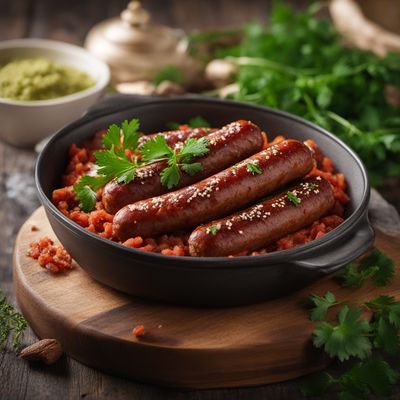
Ingredient
Weisswurst
The Bavarian Breakfast Delight
Weisswurst is a traditional Bavarian sausage that originated in Munich, Germany. It is made from a mixture of minced veal and pork back bacon, which is seasoned with parsley, mace, lemon zest, and other spices. The sausage has a delicate texture and a mild, aromatic flavor that pairs well with traditional Bavarian accompaniments like sweet mustard and pretzels.
Origins and history
Weisswurst has a rich history dating back to the 19th century in Munich, Germany. It was created as a breakfast sausage and quickly became a popular delicacy in Bavarian cuisine. Traditionally, Weisswurst was made fresh in the morning and consumed before noon, as it was believed that the sausage should not hear the church bells ring at noon. Today, Weisswurst is enjoyed throughout the day and is a staple in Bavarian cuisine.
Nutritional information
Weisswurst is a good source of protein and contains essential vitamins and minerals. It is relatively high in fat due to the use of pork back bacon in the sausage mixture. As with any sausage, it is important to consume Weisswurst in moderation as part of a balanced diet.
Allergens
Weisswurst contains pork and may not be suitable for individuals with pork allergies or dietary restrictions. It is always advisable to check the ingredient list and consult with a healthcare professional if unsure.
How to select
When selecting Weisswurst, look for sausages that have a pale, creamy color. Avoid sausages that have a grayish or brownish hue, as this may indicate spoilage. The sausages should feel firm and have a slight springiness when pressed. Additionally, check for any signs of mold or off-putting odors, as these are indicators of poor quality.
Storage recommendations
To maintain the freshness and quality of Weisswurst, store the sausages in the refrigerator. They can be kept in their original packaging or transferred to airtight containers or freezer bags. Use the sausages within a few days of purchase or freeze them for longer storage. Thaw frozen Weisswurst in the refrigerator before cooking.
How to produce
Weisswurst is typically produced by professional butchers or sausage makers using specialized equipment and techniques. However, adventurous home cooks can attempt to make Weisswurst at home using a combination of minced veal, pork back bacon, and the traditional seasonings. It is important to follow a trusted recipe and ensure proper food safety practices during the production process.
Preparation tips
Weisswurst is traditionally boiled in water or broth until cooked through. The sausages are then served hot with sweet mustard, pretzels, and other traditional Bavarian accompaniments. They can also be pan-fried or grilled for added flavor and texture. Weisswurst is a popular ingredient in Bavarian dishes like Weisswurst salad and Weisswurst breakfast platters.
Culinary uses
Weisswurst is commonly used in Bavarian cuisine, particularly in traditional breakfast dishes. It is a key ingredient in dishes like Weisswurst breakfast platters, Weisswurst salad, and Weisswurst soup. The mild and delicate flavor of Weisswurst also makes it a popular choice for sausage lovers in various recipes and preparations.
Availability
Germany



